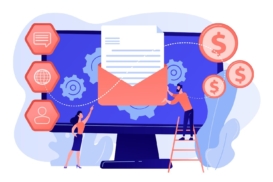Greetings! I'm Aneesh Sreedharan, CEO of 2Hats Logic Solutions. At 2Hats Logic Solutions, we are dedicated to providing technical expertise and resolving your concerns in the world of technology. Our blog page serves as a resource where we share insights and experiences, offering valuable perspectives on your queries.

Quick Summary
The chatbot vs human support debate is missing the point. The winning strategy is hybrid:
- Use chatbots for routine, high-volume inquiries (password resets, order tracking, FAQs)
- Reserve humans for complex, emotional, or high-value interactions
- Ensure seamless handoffs between bot and human
- Start small and scale based on what works
The businesses winning at customer service aren’t choosing between efficiency and empathy – they’re delivering both strategically.
Most importantly: Your customers don’t care if they’re talking to a bot or a human. They care about getting their problem solved quickly and feeling heard.
So, you’re staring at your customer service metrics, wondering if you should jump on the AI chatbot bandwagon or stick with your human support team?
Every e-commerce business owner we have worked with at 2HatsLogic has asked this exact question.
Here’s the reality: 32% of customers will abandon your brand after just one bad support experience. That’s terrifying, right? But here’s what’s even more interesting, the solution isn’t choosing between bots and humans. It’s about knowing when to use which.
Let me break this down for you based on what we have learned helping dozens of businesses nail their customer support strategy.
AI Chatbots vs Human Support
Before we dive deep, let’s get one thing straight. This isn’t a “bots vs humans” death match.
The companies winning at customer service today? They’re using both strategically.
Think of it like this: Would you use a sledgehammer to hang a picture frame? Or tweezers to demolish a wall? Each tool has its place.
When AI Chatbots Are Your Secret Weapon
Let’s be real, some customer service situations are perfect for automation. Here’s exactly when chatbots become your best friend instead of your biggest headache.
The 80/20 Rule in Customer Service
Here’s something fascinating we have noticed across all our e-commerce projects: about 80% of customer inquiries are repetitive, low-value questions. Things like:
- “Where’s my order?”
- “How do I reset my password?”
- “What’s your return policy?”
- “Are you open on weekends?”
These questions don’t need Einstein-level problem-solving. They need speed and accuracy.
According to Harvard Business Review, “84% of customers would prefer a straightforward solution to their problem” anyway.
The Chatbot Advantages That Matter
1. 24/7 Availability Without the Payroll Drama
Your customers don’t sleep. They’re shopping at 2 AM, placing orders during holidays, and having questions at the most inconvenient times.
Over 70% of consumers value the always-on convenience of AI chatbots.
2. Instant Responses (No Queue Anxiety)
Nobody likes waiting. Chatbots respond in milliseconds, not minutes.
3. Handles Volume Like a Champ
During Black Friday or product launches, human agents get overwhelmed. Chatbots? They can handle thousands of conversations simultaneously without breaking a sweat.
4. Cost Efficiency That Makes CFOs Happy
Many brands have reported up to 30% lower customer service expenses after adopting chatbots.
The Chatbot Reality Check
But let’s be honest about their limitations:
Limited Understanding of Complex Situations
Chatbots are still pretty terrible at understanding context, sarcasm, or complex multi-part questions.
Zero Emotional Intelligence
When a customer is frustrated about a delayed wedding dress order, they need empathy, not a robotic “We understand your concern.”
Maintenance Isn’t “Set and Forget”
A poorly maintained chatbot can damage your brand faster than you can say “customer satisfaction.”
Tip: Start with automating your top 5 most frequent questions. Perfect those before expanding your chatbot’s capabilities.
When Human Support Is Non-Negotiable
The Irreplaceable Human Touch
Some situations demand human intelligence, creativity, and empathy:
Complex Problem-Solving
When a customer’s order gets mixed up, is shipped to the wrong address, and they need it for tomorrow’s event, that requires human judgment and creative solutions.
High-Value Customer Relationships
Are your VIP customers spending thousands monthly? They expect white-glove service, not automated responses.
Emotional Situations
Complaints, refunds for sensitive reasons, or service failures need genuine human empathy.
The Human Advantage
Emotional Intelligence and Empathy
Humans can read between the lines, understand the frustration, and respond with genuine care.
Creative Problem-Solving
When standard solutions don’t work, humans can think outside the box and create custom solutions.
Relationship Building
Satisfaction scores remain highest when real people resolve nuanced or important issues.
The Human Reality Check
Higher Costs and Scaling Challenges
Quality human agents are expensive to hire, train, and retain.
Inconsistency Between Agents
Agent quality varies based on training, experience, and even mood.
Limited Availability
Unless you’re paying for 24/7 coverage, human support has downtime.
The Smart Money is on Hybrid Support
Here’s what we tell every client at 2HatsLogic: The best customer service strategy combines both.
How the Hybrid Model Works
- Chatbot handles initial contact – sorts inquiries, answers simple questions
- Smart escalation – detects when human intervention is needed
- Seamless handoff – passes full context to human agents
- Human agents focus on high-value interactions
Implementation That Works
Start Small and Scale
Don’t try to automate everything on day one. Begin with your most frequently asked questions and gradually expand.
Design Clear Escalation Triggers
Set specific rules for when the bot should bring in a human:
- The customer explicitly requests human help
- The bot doesn’t understand the query after 2 attempts
- Negative sentiment detected
- High-value customer identified
Train Your Team on Bot Collaboration
Your human agents should know how to work with, not against, your chatbots.
Implementation Guide For Your Chatbot Strategy
1. Audit Your Current Support Inquiries
Look at your last 1000 support tickets. What percentage is repetitive? These are your chatbot candidates.
2. Choose the Right Platform
For e-commerce, you need chatbots that integrate with your tech stack. Consider platforms like:
- Gorgias (great for e-commerce)
- Intercom (solid all-around choice)
- Zendesk Chat (enterprise-friendly)
3. Build a Robust Knowledge Base
Your chatbot is only as good as the information you feed it.
4. Test, Test, Test
Soft-launch with internal teams and beta customers before going live.
Tip: Use your actual customer language in chatbot responses. Analyze your support tickets to see how customers phrase questions and how your best agents respond.
Training Your Human Team
Hire for Empathy, Train for Skills
Look for people with natural empathy and communication skills. Technical knowledge can be taught.
Document Your Brand Voice
Create clear guidelines on tone, language, and escalation procedures.
Empower Decision-Making
Give agents authority to solve problems without constant approval chains.
What You Spend
| Support Type | Initial Investment | Ongoing Costs | Scalability |
| Chatbots | $500-5000/month setup | $100-1000/month maintenance | Excellent – handles unlimited volume |
| Human Support | $3000-6000/month per agent | Salaries + benefits + training | Expensive – new agents for more volume |
This table shows why most successful businesses use a hybrid approach, chatbots for volume and humans for value.
Making Your Decision: The Framework
You Need Chatbots If:
- 60%+ of your inquiries are repetitive
- You’re growing fast, and support costs are spiraling
- Customers complain about slow response times
- You need 24/7 support coverage
You Need Human-First If:
- Your product requires a complex explanation
- Customer relationships are your competitive advantage
- Orders are high-value and customized
- Your customers skew older and prefer human interaction
You Need a Hybrid If:
- You have both simple and complex support needs (most businesses)
- You want to scale efficiently without losing quality
- Your customers have varied preferences
- You’re serious about long-term customer success
Tip: Survey your customers about their support preferences. You might be surprised by their answers.
Common Implementation Mistakes (And How to Avoid Them)
Mistake 1: Trying to Automate Everything
The Problem: Overwhelming customers with bot interactions for complex issues.
The Fix: Use the 80/20 rule. Automate the simple stuff, keep humans for complex situations.
Mistake 2: Poor Bot-to-Human Handoffs
The Problem: Customers have to repeat themselves when escalated to humans.
The Fix: Ensure full conversation history transfers seamlessly.
Mistake 3: Neglecting Bot Maintenance
The Problem: Outdated information and poor bot performance over time.
The Fix: Regular content updates and performance monitoring.
Mistake 4: No Clear Escalation Path
The Problem: Customers get stuck in bot loops with no way out.
The Fix: Always provide an easy way to reach a human.
Ready to Transform Your Customer Service?
The right customer service strategy can make or break your e-commerce business. At 2HatsLogic, we’ve helped countless businesses design and implement customer service solutions that scale with their growth.
Whether you need chatbot implementation, human support optimization, or a complete hybrid strategy, we’ve got the expertise to get it right the first time.
Get in touch with our team and let’s design a customer service experience that your customers will love and your bottom line will thank you for.
FAQ
How do I measure if my chatbot is actually working?
Key metrics include: containment rate (% of issues resolved without human help), customer satisfaction scores, average response time, and cost per resolution. Aim for 60%+ containment rate and 4+ star satisfaction.
What's the biggest mistake businesses make with chatbots?
Trying to automate everything on day one. Start with your top 5-10 most common questions, perfect those, then gradually expand. Also, never hide the fact that customers are talking to a bot.
Can chatbots handle multiple languages for international customers?
Yes, most advanced chatbot platforms support multiple languages. However, each language requires separate training and maintenance. Start with your primary market language and expand gradually.
Table of contents
- AI Chatbots vs Human Support
- When AI Chatbots Are Your Secret Weapon
- When Human Support Is Non-Negotiable
- The Smart Money is on Hybrid Support
- Implementation Guide For Your Chatbot Strategy
- Making Your Decision: The Framework
- Common Implementation Mistakes (And How to Avoid Them)
- Ready to Transform Your Customer Service?

Related Articles







